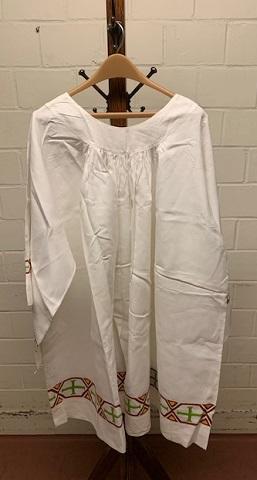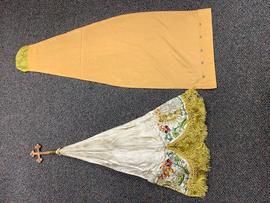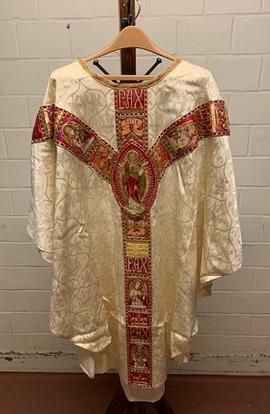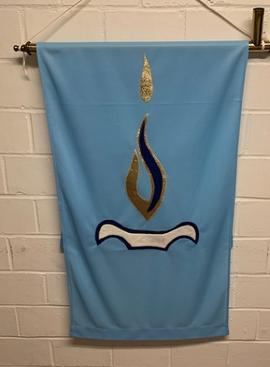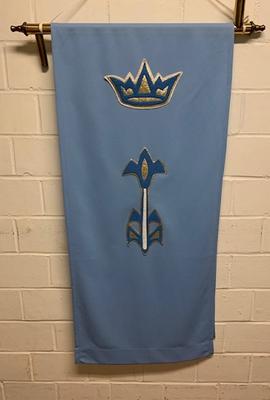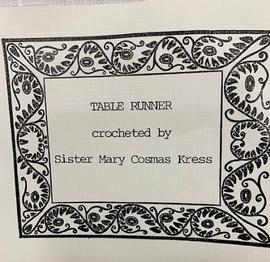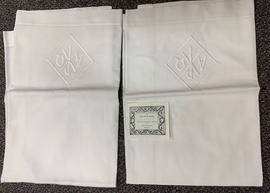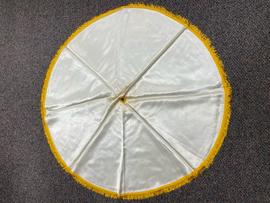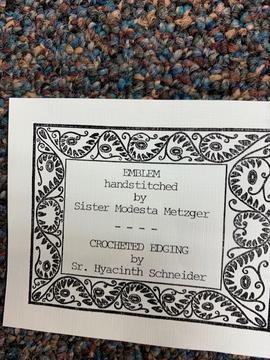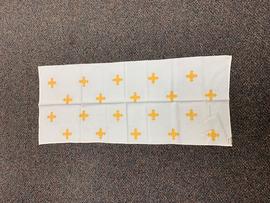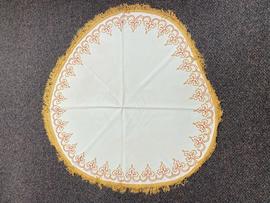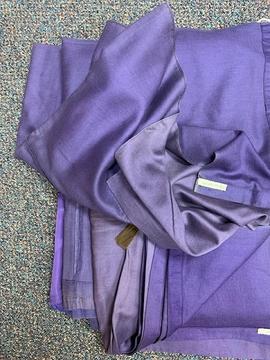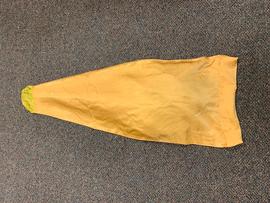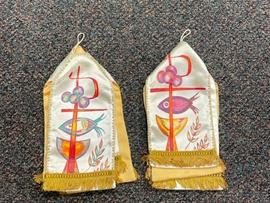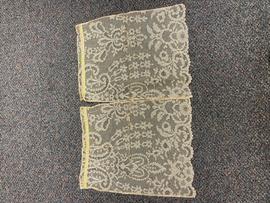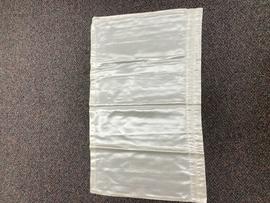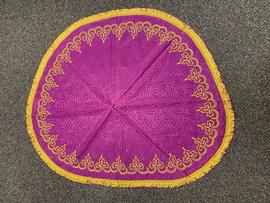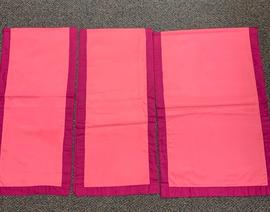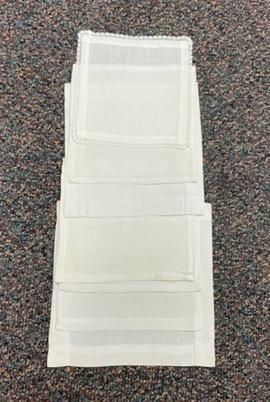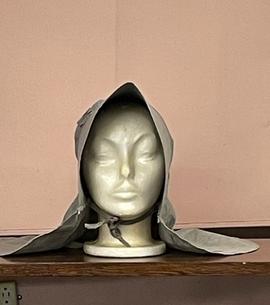The alb, embroidered tablecloth, and chalice cards were made by the Ferdinand sisters in their own Vestment Department (Stitching room).
Sans titreMonastery Artifacts/Memorabilia
96 Description archivistique résultats pour Monastery Artifacts/Memorabilia
The alb, embroidered tablecloth, and chalice cards were made by the Ferdinand sisters in their own Vestment Department (Stitching Room).
Sans titreThe alb, embroidered tablecloth, and chalice cards were made by the Ferdinand sisters in their own Vestment department (Stitching Room).
Sans titreThis newspaper was given to Sister Mary Aquin Verkamp on June 16, 2002 as a souvenir of her First Profession on June 2, 1952.
Sans titreThe Monastery Immaculate Conception became an official member of the Congregation of St. Gertrude the Great on October 16, 1939.
Sans titreThe PIETA, located in the monastery church vestibule, was contributed to the monastery. The donor is unidentified. The statue was restored by Lennea Thrasher and Marilyn Longmeier of Birdseye, Indiana, and delivered May 23, 2007.
These altar cloths and table cloths were sewn and hand-stitched in the monastery stitching department (vestment department)
Sans titreThese are tabernacle curtains used in the monastery chapel which were probably made by the sisters in the former vestment department (stitching room). These curtains, green red, purple and white, were changed for different liturgical seasons and for feast days.
Sans titreThese are tabernacle curtains used in the monastery chapel which were probably made by the sisters in the former vestment department (stitching room). These curtains, green,red,purple and white, were changed for different liturgical seasons and for feast days.
Sans titreThis cover was probably made by the sisters in the former vestment department (stitching room). These green, red, purple and white, were changed for different liturgical seasons and for feast days.
Sans titreThese items were sent to the archives by Sister Mary Carmel Spayd, sacristan, on February 25, 1999.
Sans titreThese items were sent to the archives by Sister Mary Carmel Spayd, sacristan, on February 25, 1999.
Sans titreThese items were sent to the archives by Sister Mary Carmel Spay, sacristan, on February 24, 1999.
Sans titreThese items were sent to the archives by Sister Mary Carmel Spayd, sacristan, on February 25, 1999.
Sans titreThese items were sent to the archives by Sister Mary Carmel Spayd, sacristan, on February 25, 1999.
Sans titreThese items were sent to the archives by Sister Mary Carmel Spayd, monastery sacristan. The liturgical artifacts in this box were used in the monastery chapel or in the infirmary chapel (before 1993-1995 renovation) and before liturgical changes after Vatican II.
Sans titreThese items were sent to the archives by Sister Mary Carmel Spayd, monastery sacristan. The liturgical artifacts in this box were used in the monastery chapel or in the infirmary chapel (before 1993-1995 renovation) and before liturgical changes after Vatican ll.
Sans titreThe canopy with the carry rod was used by the Ferdinand Benedictines and was probably made at the monastery. The antependium may or may not have been used by the Ferdinand Benedictines. It appears on no photographs. The Blessed sacrament canopy was carried in processions of the Blessed Sacrament as an act of reverence. Albert Krampe carried out this task for several decades.
Sans titreThese articles, made at the monastery, were used in the monastery chapel through the year 2000.
Sans titreThese items were made by the Vestment department for use in Liturgical services. Four blue liturgical banners with gold Marian symbols, and a red and wine altar antependium with a symbol for the Holy Spirit.
Sans titreThese items were made by the Vestment Department for use in Liturgical services. Four blue liturgical banners with gold Marian symbols, and a red and wine altar antependium with a symbol for the Holy Spirit.
Sans titrePhoto copy, photograph, history, Ferdinand
Sans titreThese palls, pall covers, the chalice cover and pix case were made by hand by members of the stitching department over many, many years.
Sans titreThese palls, pall covers, the chalice cover and pix case were made by hand by members of the stitching department over many, many years.
Sans titreThese handmade, hand stitched items were used in the Monastery Infirmary Chapel and main Monastery Chapel.
Sans titreThese handmade, hand stitched items were used in the Infirmary Chapel and main Monastery Chapel.
Sans titreThese handmade, hand stitched items were used in the Monastery Infirmary Chapel and Main Monastery Chapel.
Sans titreThis bonnet was given to the archives by Sister Jovita Scheessele who worked in the sisters' produce garden for years. The bonnet in this box reflects the hard, outdoor work, particularly produce gardening, in which the Ferdinand Benedictines have always been involved.
Sans titreThe statue of the Child Jesus was brought to Ferdinand in 1867 by Mother Alexia Lechner, O.S.B., of St. Walburg Monastery, Covington, Kentucky.
Sans titreFather Eric Lies, O.S.B., St. Meinrad monk and artist, produced the mission statment in original calligraphy.
Sans titreA news story carrying a description of Stanley Slotkin's book and bible collections and his method of contributing these to others is in this collection.
Sans titreThese are tabernacle curtains used in the monastery chapel which were probably made by the sisters in the former vestment department (stitching room). These curtains, green, red, purple and white, were changed for different liturgical seasons and for feast days.
Sans titreThese are tabernacle curtains used in the monastery chapel which were probably made by the sisters in the former vestment department (stitching room). These curtains, green, red, purple and white, were changed for different liturgical seasons and feast days.
Sans titreThese monstrance covers were probably made by the sisters in the former vestment department (stitching room).
Sans titreThis monstrance cover was probably made by the sisters in the former vestment department (stitching room).
Sans titreThis monstrance cover was probably made by the sisters in the former vestment department (stitching room).
Sans titreThese satin table covers were probably made by the sisters in the former vestment department (stitching room). These covers, green, red, purple and white, were changed for different liturgical seasons and feast days.
Sans titreThese items were sent to the archives by Sister Mary Carmel Spayd, sacristan, on February 25, 1999.
Sans titreThese items were sent to the archives by Sister Mary Carmel Spayd, sacristan, on February 25, 1999.
Sans titreThe canopy with the carry rod was used by the Ferdinand Benedictines and was probably made at the monastery. The antependium may or may not have been used by the Ferdinand Benedictines. It appears on no photographs. The Blessed Sacrament canopy was carried in processions of the Blessed Sacrament as an act of reverence. Albert Krampe carried out this task for several decades.
Sans titreThe canopy with the carry rod was used by the Ferdinand Benedictines and was probably made at the monastery. The antependium may or may not have been used by the Ferdinand Benedictines. It appears on no photographs. The blessed Sacrament canopy was carried in processions of the Blessed Sacrament as an act of reverence. Albert Krampe carried out this task for several decades.
Sans titreThese articles, made at the monastery, were used in the infirmary chapel through the year 2000.
Sans titreThese articles, made at the monastery, were used in the infirmary chapel through the year 2000.
Sans titreThese items were made by the Vestment department for use in Liturgical services. Four blue liturgical banners with gold Marian symbols, and a red and wine altar antependium with a symbol for the Holy Spirit.
Sans titreThe first monastery church ceiling comprised a process using horsehair, canvas, and wood.
Sans titreThese palls, pall covers, the chalice cover and pix case were made by hand by members of the stitching department over many, many years.
Sans titreFather Adolph Egloff left this pillow with Sister Mary Adolph, O.S.B., his sister, in August, 2001. Sister Mary Adolph gave the pillow to Sister Eileen Reckelhoff who sent it to the Archives.
Sans titreFather Adolph Egloff left this pillow with Sister Mary Adolph, O.S.B., his sister, in August 2001. Sister Mary Adolph gave the pillow to Sister Eileen Reckelhoff who sent it to the Archives.
Sans titreThese handmade, hand stitched items were used in the Monastery Infirmary Chapel and main Monastery Chapel.
Sans titreThese handmade, hand stitched items were used in the Monastery Infirmary Chapel and main Monastery Chapel.
Sans titreThis bonnet was given to the archives by Sister Jovita Scheessele who worked in the sisters' produce garden for years. The bonnet in this box reflects the hard, outdoor work, particularly produce gardening, in which the Ferdinand Benedictines have always been involved.
Sans titreThis bonnet was given to the archives by Sister Jovita Scheessle who worked in the sisters' produce garden for years. The bonnet in this box reflects the hard, outdoor work, particularly produce gardening, in which the Ferdinand Benedictines have always been involved..
Sans titreThe alb, embroidered tablecloth, and chalice cards were made by the Ferdinand sisters in their own Vestment Department (Stitching Room).
Sans titreThe alb, embroidered tablecloth, and chalice cards were made by the Ferdinand sisters in their own Vestment Department (Stitching Room).
Sans titreThe alb, embroidered tablecloth, anf chalice cards were made by the Ferdinand sisters in their own Vestment Department (Stiching Room).
Sans titreThe alb, embroidered tablecloth, and chalice cards were made by the Ferdinand sisters in their own Vestment Department (Stitching Room).
Sans titreInventory of exhibit items, museum information,
Sans titreThis satin table cover was probably made by the sisters in the former vestment department (stitching room). These covers, green, red, purple and white, were changed for different liturgical seasons and for feast days.
Sans titreThis table cover was probably made by the sisters in the former vestment department (stitching room). These covers, green, red, purple and white, were changed for different liturgical seasons and for feast days.
Sans titreThese items were sent to the archives by Sister Mary Carmel Spayd, monastery sacristan. The liturgical artifacts in this box were used in the monastery chapel or in the infirmary chapel(before 1993-1995 rennovation) and before liturgical changes after Vatican ll.
Sans titrePatens were placed under the chin when one received the Holy Eucharist.
Sans titreThe canopy with the carry rod was used by the Ferdinand Benedictines and was probably made at the monastery. The antependium may or may not have been used by the Ferdinand Benedictines. It appears on no photographs. The Blessed sacrament canopy was carried in processions of the Blessed Sacrament as an act of reverence. Albert Krampe carried out this task for several decades.
Sans titreSome of these items were brought to the archives by Sister Kathryn Huber who received them from Sister Mary Cosmas Kress. Others were sent to the archives by Sister Mary Cosmas.
Sans titreThese articles, made at the monastery, were used in the infirmary chapel through the year 2000.
Sans titreThese items were made by the Vestment Department for use in Liturgical services. Four blue liturgical banners with gold Marian symbols, and a red and wine altar antependium with a symbol for the Holy Spirit.
Sans titreThese items were made by the Vestment Department for use in Liturgical services. Four blue liturgical banners with Gold Marian symbols, and a red and wine altar antependium with a symbol for the Holy Spirit.
Sans titreThese palls, pall covers, the chalice cover and pix case were made by hand by members of the stitching department over many, many years.
Sans titreThese palls, pall covers, the chalice cover and pix case were made by members of the stitching department over many, many years.
Sans titreThese altar cloths and table cloths were sewn and hand-stitched in the monastery stitching department (vestment department)
Sans titreThe needlepoint representation of Mary as the Immaculate Conception was brought to Ferdinand by Mother Alexia Lechner, O.S.B., prioress of St. Walburg Monastery in Covington, Kentucky
Sans titreAnnemarie Springer from Bloomington helped to evaluate pieces in the IHRG collection and took photographs of them.
Sans titrePoster, German, 1870
Sans titreOriginal charcoal sketch, copies, convent seal
The Sisters of St. Benedict of Ferdinand were participants in this festival with a number of items in the exhibit.
Sans titreThe alb, embroidered tablecloth, and chalice cards were made by the Ferdinand sisters in their own Vestment Department (Stitching Room).
Sans titreThe alb, embroidered tablecloth, and chalice cards were made by the Ferdinand sisters in their own Vestment Department (Stitching Room).
Sans titreThe alb, embroidered tablecloth, and chalice cards were made by the Ferdinand sisters in their own Vestment Department (Stitching Room).
Sans titreThis wreath belonged to a Ferdinand Benedictine who transferred to Our Lady of Grace Monastery, Beech Grove, in 1961. Profession wreaths were used over many decades of the monastery's history.
Sans titreThese are tabernacle curtains used in the monastery chapel which were probably made by the sisters in the former vestment department.(stitching room). These green, red, purple and white, were changed for different liturgical seasons and for feastdays.
Sans titreThese are tabernacle curtains used in the monastery chapel which were probably made by the sisters in the former vestment department (stitching room). These curtains, green, red, purple and white, were changed for different liturgical seasons and for feast days.
Sans titreThese are tabernacle curtains used in the monastery chapel which were probably made by the sisters in the former vestment department (stitching room). These curtains, green, red, purple and white, were changed for different liturgical seasons and for feast days.
Sans titreThese satin table covers used in the monastery chapel were probably made by the sisters in the former vestment department (stitching room). These covers, green, red, purple and white, were changed for different liturgical seasons and for feast days.
Sans titreThis satin table cover was probably made by the sisters in the former vestment department (stitching room). These covers, green, red, purple and white, were changed for different liturgical seasons and for feast days.
Sans titreThese items were sent to the archives by Sister Mary Carmel Spayd, sacristan, on February 25, 1999.
Sans titreThese items were sent to the archives by Sister Mary Carmel Spayd, sacristan, on february 25, 1999.
Sans titrePink and rose cloths for Gaudete. These items were sent to the archives by Sister Mary Carmel Spayd, monastery sacristan. The liturgical artifacts in this box were used in the monastery chapel or in the infirmary chapel (before 1993-1995 renovation) and before liturgical changes after Vatican ll.
Sans titrePatens were placed under the chin when one received the Holy Eucharist.
Sans titreThe canopy with the carry rod was used by the Ferdinand Benedictines and was probably made at the monastery. The antependium may or may not have been used by the Ferdinand Benedictines. It appears on no photographs. The Blessed Sacrament canopy was carried in processions of the Blessed Sacrament as an act of reverence. Albert Krampe carried out this task for several decades.
Sans titreThese items were made by the Vestment Department for use in Liturgical services. Four blue liturgical banners with gold Marian symbols, and a red and wine altar antependium with a symbol for the Holy Spirit.
Sans titreThese altar cloths and table cloths were sewn and hand-stitched in the monastery stitching department (vestment department)
Sans titreThe contents in this file were discovered buried in the concrete blocks supporting the marble altar which was dismantled during the restoration of the interior of the monastery church in 2004.
Sans titreThese palls, pall covers, the chalice cover and pix case were hand made by members of the stitching department over many, many years.
Sans titreThis bonnet was given to the archives by Sister Jovita Scheessele who worked in the sisters' produce garden for years. The bonnet in this box reflects the hard, outdoor work, particularly produce gardening, in which the Ferdinand Benedictines have always been involved.
Sans titre









